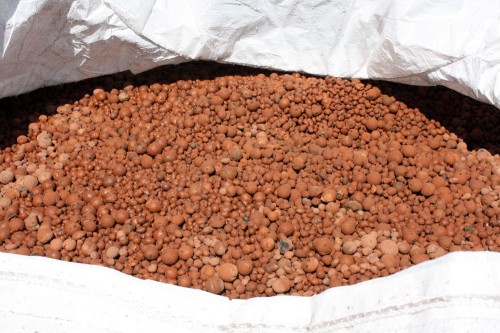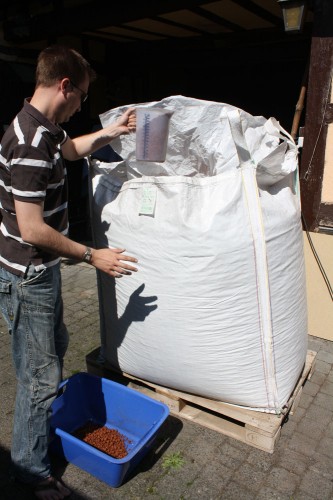I talked a little bit yesterday about the different types of aquaponics growing media that are available for consideration. As I mentioned, we went with expanded clay pebbles (4-16mm big) which were actually made exactly for this purpose. The exact pebbles we got are actually a brand new type of aquaponics pebble that is hitting the market so we were really excited to be one of the firsts to try them.
Because we’re planning several aquaponics systems around our homestead, we went ahead and bought all of them at once. One ton of pebbles…literally. It is a HUGE amount. We’re kinda wondering if maybe it wasn’t too many…but we will eventually build strawberry aquaponics towers and tube towers for lettuce and herbs, so at least we won’t be running out. I even used some of them in a flower vase recently to anchor the stems in place. A few of them floated the entire time, but it mostly worked out great.
One of the more mind-numbing parts of filling the aquaponics bed is washing the pebbles (or other growing media) you are using. If it’s coming straight from the factory or quarry, there will be a LOT of dust. In some cases, you might even have to rinse the pebbles a few times.
Stefan once started this process in our bathtub, going gallon by gallon, bucket by bucket until the water started to run clear. But then we remembered we had some large unused plastic tubs that already had little holes in the bottom since they’d been experimental tubs for our worm farm. So we filled them up with pebbles, added lots of water from our well, and just kept moving the pebbles around in the tubs with our hands, trying to get the dust to settle to the bottom and wash out. Over and over until the water was mostly clear. I say mostly because it may have taken hours per tub to get it fully clear…but it was a massive improvement over when we started. You don’t want all that dust in your system because it will clog up in your fish tank and just increase the sediment buildup overall.
Once the pebbles were washed, they went into the growing bed which we’d previously lined with black pond foil. As we filled the bed, we worked the liner around a bit to make sure all the corners were filled out and nothing could escape.
We also realized that we would need to put a net around the drain tube because the smaller pebbles would easily fall through into the sump tank. In retrospect (since we were still planning to build a siphon drain) we should have just put a bucket around this area with the bottom cut out so we could work on the drain without the pebbles being in the way. Hindsight is 20/20.
So here’s how things were looking at the end of the day with all the pebbles inside the grow bed. It took us the better part of the afternoon to wash them but it actually went fairly smoothly since we were using the two large tubs. We’ve cut back a bit of this lilac tree already because it kept attacking Stefan when he would get into the sump tank, but since it casts a lot of shade on the bed during the day, we may take a few more branches out that hang right over the bed. It’s also a bit of a pain to pick all the lilac blossoms and leaves out of the bed. But during the summer, our lettuce always gets scorched on this side of the house, so I think that a little shade won’t be a bad thing either.
Once we had all the pebbles in, we just needed to trim off the overage of the pond liner and used a staple gun to hold it in place. Around the corners where we had a large gathering of foil, we trimmed it off just below the inside edge of the grow bed. The water level should never be high enough that is spills over and the wood beams we used around the edge to trim off the bed cover all the messiness up.
Here you can see that Stefan made nice angled cuts on the corners so it looks pretty. We chose unfinished wood so that no chemicals will leach off the wood into the aquaponics system.
Now you’re quite possibly still not really sure what we’ve done here or why…but have no fear — there’s more aquaponics how to information up ahead. As I briefly have mentioned before, we’re going to build an aquaponics system in our greenhouse out back since it will be so easy to maintain and also keep the tank really warm while the plants remain watered. We’re hoping to ultimately grow crayfish somewhere here and they, as well as the tilapia, need it pretty warm to really thrive. Since we’ll have a better idea about what we’re doing now, we’ll be including plenty of video so that you can get started on your own aquaponics system soon. 🙂












I admire your enthusiasm ordering a ton of the clay pebbles! In my older age, I’ve learned to buy only exactly what you need next in your project and use it right away. I have a lot of good ideas tucked away in the back of the garage 🙂
The jury is still out on this aquaponics thing. I’m following with interest, but I still think it’s easier to go down to the river and fish out a trout and come home and pick some lettuce from the garden.
@SteveR — Yeah we tend to overdo things at times. But with this bag looming in our courtyard, it’s motivation to get the beds in the greenhouse up and running. 🙂
I’m glad you’re following the aquaponics developments and I know it’s not something for everyone. It requires a bit of tinkering and some nerdy interests to get it going. Thankfully my husband is really into it. But it keeps us from having to do a lot of plowing, weeding and so on which we definitely appreciate. And once the levels are balanced out in the system, plants in the grow beds should produce a whole lot faster than our other plants. As for the fishing, we don’t have a license here in Germany and everything is restricted…so it’s nice to have a way around all that mess plus buying more gear. Fishing would be a nice way to relax while getting food but it’s something we just don’t have the time for right now. 🙂
fun story! You might also consider using a perforated piece of 6″ PVC over your siphon to block the media. I just expanded the holes in mine to a 9/32 drill bit size.
What is new about the new media? It looks like Hydroton…
Best of luck with your new system! I’ll look forward to more great stories.
Hi Sylvia,
It is hydroton but this company Easy Green/Oekotau (which has been making general hydroton for plants for a while) now has this hydroton product from which was developed specifically for aquaponics systems. We noticed a lot less dust coming off of it when we cleaned it and they say on their website that it’s made from “special types of clay that have low soluble salt content hence particularly suited for use in Aquaponics systems.”
We have a larger PVC pipe in place now for our siphon — just no photos or details up about it yet. It definitely is a major help to keep the siphon working.
Congrats on guest blogging for Growing Edge — they are a wonderful resource! And so is your community. I’ll be sure to join soon 🙂
Thanks for dropping by!
Tiffany,
since about 3 weeks my aquaponic system is alive! 65 Tilapia Mariae moved in – I had to pick them up in Germany.
The plants doing great, so does the fish.
You can have a look at:
http://www.facebook.com/photo.php?pid=226165&l=e048715d68&id=100000693008208
All the best,
Kurt
hi there read up on the aquaponic system and have decided to give it ago due to the fact our garden gets waterlogged(heavy clay soil)
i have obtained a ibc container in which to set up on , i have a fish pond in back yard so think it would make a great filter system as well so i get 2 for 1, it is koy carp so dont really wish to change,
the question i have is when i put pipe in centre to drain back to fish pond how much below the gravel / media do you recommend the holes should be in pipe so as not to waterlog the plant roots, nd so they grow well.
could you supply info back to my email address as almost ready to complete ([email protected])
many thanks graham
Where can I find this pond foil you used?
We bought it at our local home improvement store in the pond area. It’s a thick plastic foil, probably around 2mm thick.